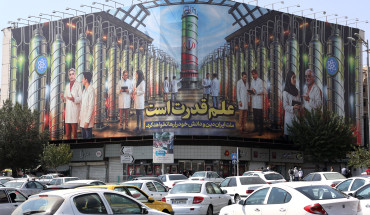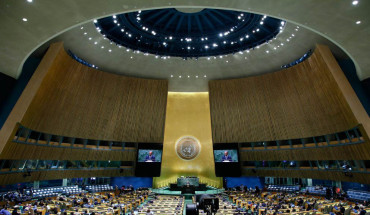Originally posted July 2011
What is the value of a liberal education in a Middle Eastern academic context? For that matter, what is the place of such education in American academia? In the early 20th century, the answer was clear: a liberal education was the vessel by which Western civilization’s Renaissance-Humanist heritage was passed to young students.[1] In the mid-20th century, Carnegie Mellon University’s influential “Carnegie Plan” made a different case for liberal education, arguing that professional degrees should be infused with liberal education in order to teach critical thinking and real-world problem-solving skills. A generation later, scholars such as Roger Shattuck and E.D. Hirsch made the case that a liberal education provided students with the “cultural literacy” needed to navigate modern society successfully.[2] Most recently, Harvard University Task Force on General Education proffered the most radical apology for a liberal education yet, arguing that the “aim of a liberal education is to unsettle presumptions, to defamiliarize the familiar … to disorient young people, and to help them to find ways to reorient themselves.”[3]
Despite such impassioned defenses, liberal education plays a weaker role in American academe today than almost ever before. According to a 2005 article in the Journal of Higher Education, the number of degrees granted in traditional liberal disciplines dropped from about 70% in 1915 to only 40% in 2000. Liberal education degrees remained strong until the 1930s, when the Great Depression encouraged colleges to provide degrees that would help students find jobs rather than find themselves. Professional degrees gained a further boost from the end of WWII, when the GI bill flooded colleges with older students seeking the skills needed to re-integrate into the civilian work force. During the late 1960s, post-Sputnik government funding for the hard sciences and the prevailing culture of social critique fueled a temporary revival in classic liberal education degrees. By the late 1970s, however, professional degrees had reasserted themselves. Between 1970 and 2000, the number of students earning philosophy, social science, mathematics, and English literature degrees dropped substantially, while public administration, business, and computer science spiked in popularity. Today, liberal education degrees remain prevalent in only a handful of American educational sectors, including highly selective, prestigious schools somewhat protected by their reputations from the prevailing winds of the educational market.[4]
Fair enough, but to what extent have education trends in the Middle East regarding liberal education tracked those in the United States? Little work has been done on this issue, and the studies that exist give impressionistic data. For example, a recent publication by The Washington Institute for Near East Policy by Shafeeq Ghabra and Margreet Arnold argued that “most degrees [offered in the Middle East] are technical or science related, or business … very few universities offer degrees in the fine arts, history, and the social sciences.” They also contended that liberal education in the Middle East suffers from “an anti-humanities and social sciences culture that stems from the old thinking of strict employability within fields of study.” However, they present mostly anecdotal evidence in support of these conclusions.[5]
In search of more definitive data, I conducted my own informal survey of the state of liberal education in the Middle East using some of the tools provided by the JHE study. I was not able to duplicate this study exactly: it relied on a central database of liberal education vs. professional degrees awarded to American university students per year, and no such database exists for Middle Eastern universities. Rather, I conducted a thorough search of the web sites of 24 larger Middle Eastern universities - 12 public, 12 private - to determine how many “professional” and/or “liberal” degree programs they offered, as defined by the JHE article.[6] Although I am counting degree programs rather than degrees given, I was confident that this procedure should produce comparable, though not entirely congruent, results.
What I found is that Middle Eastern curricular trends on the subject of liberal arts largely track American developments. Overall, only 30% of the degrees offered in both public and private universities can be categorized as “liberal education” degrees, even less than are granted by American higher education. This aligns closely to the more impressionistic data provided by the WINEP study. Other indications further underscore the underlying similarity between American and Middle Eastern educational trends. In the five “American Universities” on the list, including the well-known American University of Beirut and the American University of Cairo, liberal arts degrees make up 44% of all degrees offered. This aligns well with the JHE study’s findings that selective and prestigious schools disproportionally offer a liberal education.
Middle Eastern universities also track American universities in curricular changes over time. Most major Middle Eastern public universities, when first founded, had a strong liberal educational core, but subsequently added professional degrees. In 1977, for example, the only “professional” degree offered at Qatar University was education, but schools of engineering, business, and economics were founded in 1985, while pharmacy was added in 2008. King Saud University began in 1957 with a college of arts, then gained departments of business and pharmacy (1960), agriculture (1966), and computer and information sciences (1984). Similarly, Alexandria University began only with colleges of arts and law, then gained departments of nursing (1954), pharmacy (1956), education (1969), veterinary medicine (1974), and tourism/hotel studies (1983). Middle Eastern universities, then, have probably gone even farther than their American counterparts in embracing the professions and departing from the old liberal education core.
Nonetheless, there are reasons to think that liberal education may soon play a more prominent role in Middle Eastern universities. Elsewhere in the non-Western world, universities are beginning to reincorporate the spirit of a liberal education into their elite academic programs. In recent years, for example, Peking University introduced the Yuanpei Honors Program, which is designed to teach creative thinking by exposing students to an interdisciplinary core curriculum. Similar programs have been set up elsewhere in China and in South Korea and Singapore. The impetus behind these programs, according to international education expert Richard C. Levin, is that “the Chinese and the others in Asia are worrying that their students lack the independence and creativity necessary for their countries’ long-term economic growth.” Levin argues that Asian universities have traditionally focused on mastery of content rather than “development of the capacity for independent and critical thinking,” which a liberal education can provide.[7]
The same wind of change is now blowing through India’s universities. According to Amrit Dhillon, liberal education promises to overturn a “cultural tradition of deference … to authority” that severely inhibits critical thinking in Indian higher education.[8] What is more, the Indian educational system has been weighted heavily towards the professions, with business, engineering, and IT schools receiving the bulk of state funds, while humanities and social science schools receive “only crumbs.”[9] This is a huge mistake, some Indian educational reformers believe, as “new knowledge and new insights have often originated at the boundaries of disciplines,” and “there are no great universities in the world that do not simultaneously conduct world class programs” in both professional and liberal education fields.[10] Advocates of Indian educational change also argue that liberal education degrees are crucial to providing “effective leadership,” and “out-of-the-box lateral thinking.”[11] Several institutions have recently risen in India to push this reformed vision of education forward, including the Foundation for Liberal and Management Education (FLAME), which offers a liberal education degree as well as business, communication, and performing arts degrees that are all “anchored” to a liberal education model.[12]
A similar pattern of re-thinking the role of liberal education in academia is underway elsewhere in the Indian subcontinent. Since 1992, when Bangladesh began to allow private universities, a number of liberal education institutions have sprung up in Bangladesh, most notably the University of Liberal Arts Bangladesh (2002) and the Asian University for Women (2008). Both institutions offer a range of liberal arts and science degrees in a country where narrow professional education is the norm. On the other end of the subcontinent, Habib University is slated to open in Pakistan in 2012 with a similar mission of importing a liberal education program into an educational culture dominated by narrow professional education.
Will these incipient steps towards reincorporating liberal education into the university curriculum find traction in the Middle East? Perhaps. The imminent opening of New York University’s unabashedly liberal education campus in Abu Dhabi and Bard College’s more modest liberal arts and sciences partnership with Al-Quds University in Jerusalem may be a sign of things to come. However, what is still lacking in the Middle East is an indigenous public debate as to what benefit liberal education offers to society. As we have seen, American academia has already debated this point robustly, while the Chinese, Indians, and other Asian nations are now undergoing this process of introspection. True, voices have been raised concerning the utility of a liberal education in the Middle East, but these voices mostly belong to expatriates and outsiders to the region.[13] Until a substantive internal debate occurs, it is unlikely that liberal education will sink deep roots into the universities of the Middle East.
[1]1. See for example Karl E. Shedd, “The Liberal Arts at Mid-Century,” South Atlantic Bulletin, Vol. 18, No. 4 (March 1953).
[2]. Roger Shattuck, “Perplexing Dreams: Is There a Core Tradition in the Humanities?” American Council of Learned Societies (April 1987); E.D. Hirsch, Cultural Literacy: What Every American Needs to Know (New York: Random House, 1988).
[3]. Report of the Task Force on General Education. Harvard University Faculty of Arts and Sciences (2007), pp. 1-2.
[4]. Steven Brint et. al., “From the Liberal to the Practical Arts in American Colleges and Universities: Organizational Analysis and Curricular Change,” The Journal of Higher Education, Vol. 76, No. 2 (March-April 2005), pp. 151-80.
[5]. Shafeeq Ghabra and Margreet Arnold, “Studying the American Way: An Assessment of American-Style Higher Education in Arab Countries.” The Washington Institute For Near East Policy, Policy Focus #71 (Jun., 2007), pp. 13-14.
[6]. Public: Zayed University, Qatar University, King Saud University, University of Jordan, Sultan Qaboos University, Alexandria University, University of Kuwait, The Higher Colleges of Technology (UAE), University of Damascus, Ain Shams University (Egypt), University of Bahrain, and Assiut University (Egypt). Private: American University of Cairo, American University of Beirut, American University of Kuwait, American University of Sharjah, Lebanese American University, Misr International University, October 6 University (Egypt), Modern Sciences and Arts University (Egypt), Saint Joseph University (Lebanon), University of Kalamoon (Syria), Al-Zaytoonah Private University (Jordan), and Education City (Qatar).
[7]. Richard C. Levin, “Top of the Class: The Rise of Asia’s Universities,” Foreign Affairs, Vol. 89, No. 3 (May/June 2010), pp. 70-72.
[8]. Amrit Dhillon, “More Than a Billion People But Where Are the Thinkers,” Times Higher Education, April 14, 2010.
[9]. Shreesh Chaudhury, “India: Science and Technology vs the Humanities,” University World News, May 30, 2010.
[10]. Yash Pal, “Forward,” Report of the Committee to Advice on Renovation and Rejuvenation of Higher Education, p. 2, p. 4. Available on-line from http://www.hinduonnet.com/nic/yashpalreport.htm.
[11]11. Aziz Haniffa, “India Needs Leaders at Many Levels: Sam Pitroda.” Rediff.com Business, August 29, 2009; “How to Reform Higher Education In India.” Businessworld, April 14, 2010. See also, Binu S. Thomas, “Rising Stress on Liberal Arts Education.” India Together, Feb 2003.
[13]. See for example David R. Blanks, “Cultural Diversity of Cultural Imperialism: Liberal Education in Egypt,” Liberal Education (Summer, 1998), pp. 30-35.
The Middle East Institute (MEI) is an independent, non-partisan, non-for-profit, educational organization. It does not engage in advocacy and its scholars’ opinions are their own. MEI welcomes financial donations, but retains sole editorial control over its work and its publications reflect only the authors’ views. For a listing of MEI donors, please click here.













